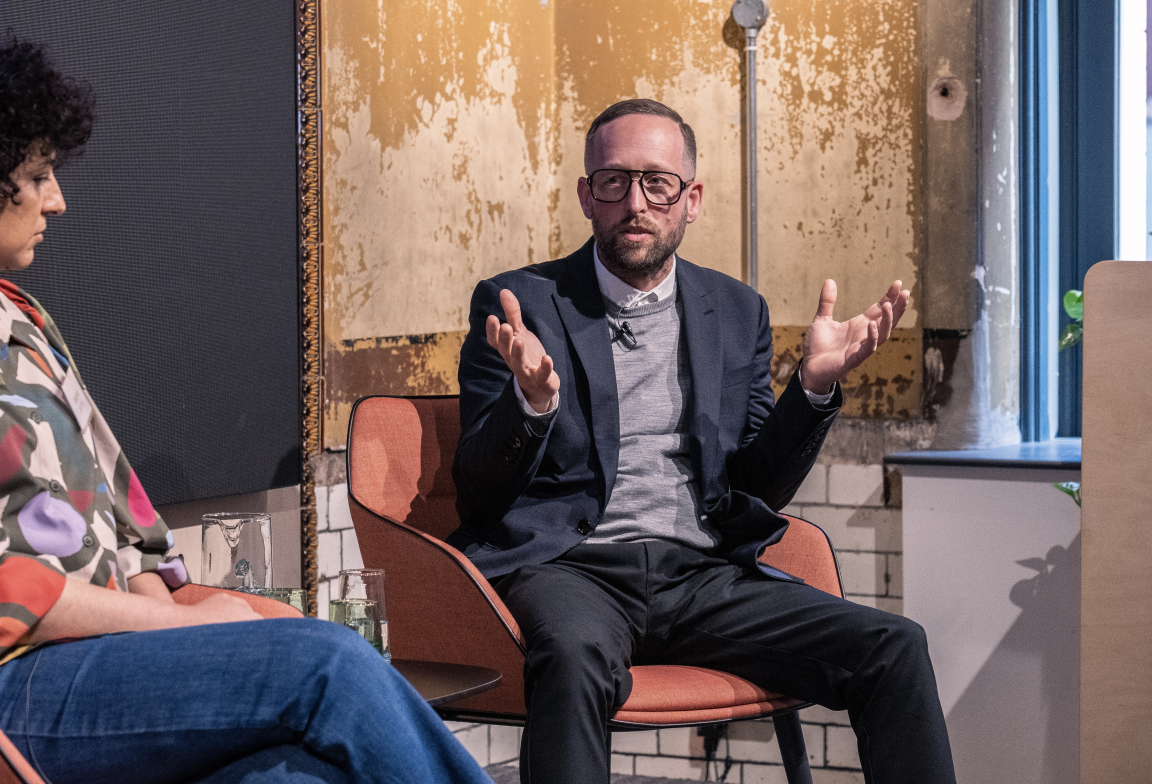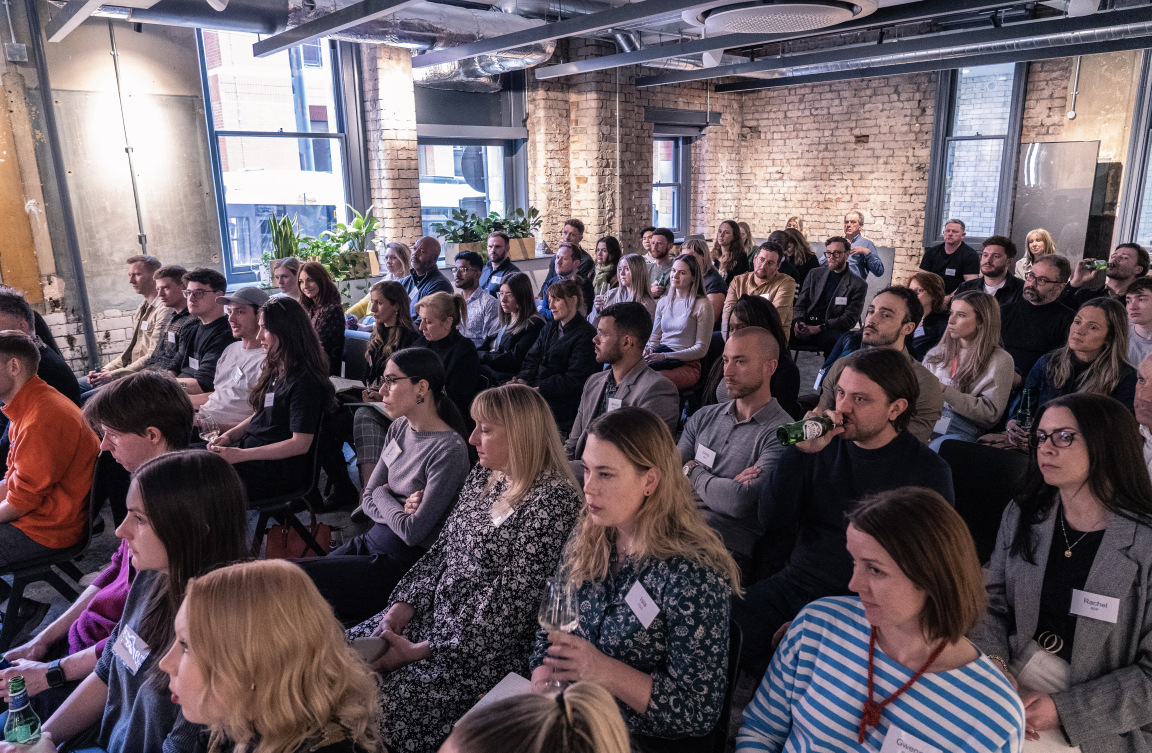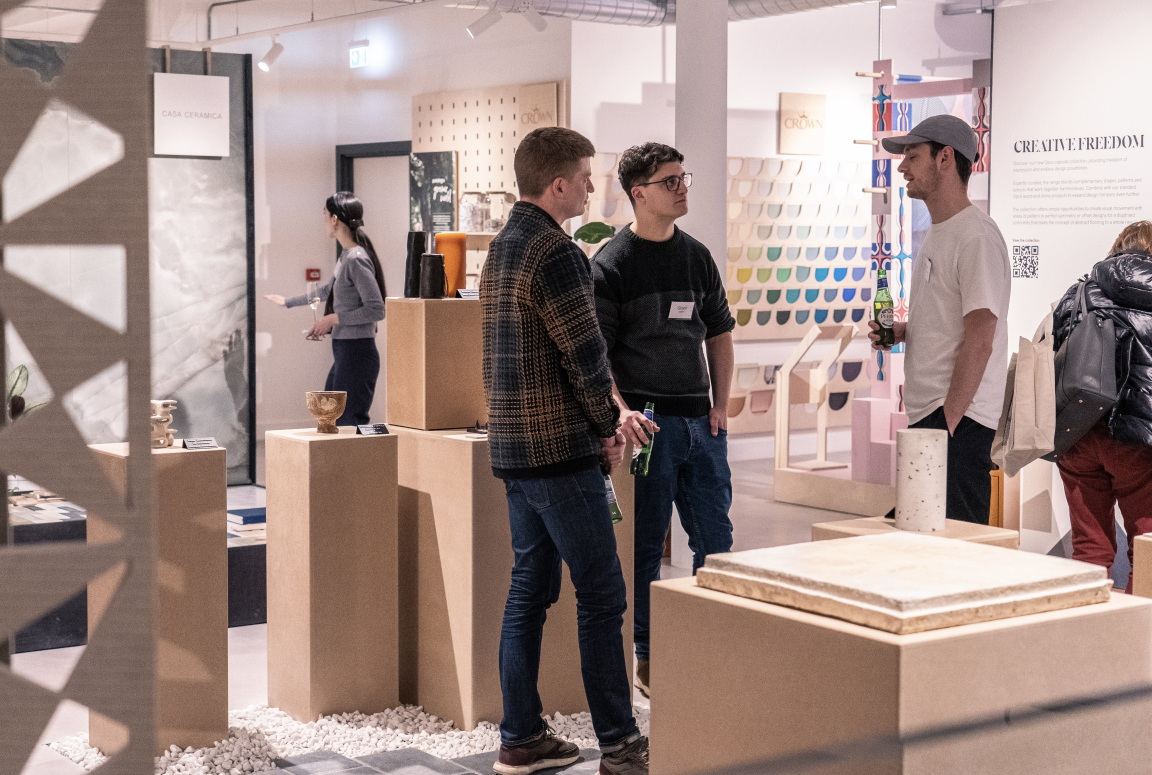Material Source Studio Presents: Technology.

Photography by Tim Ainsworth
Tackling the timely yet expansive topic of technology, the Material Source Studio Presents series returned for its third seminar of the year.
Joining host and Material Source director, David Smalley on the stage were our three future-thinking panellists, offering experienced thought-leadership on the subject. Atepheh Amid is an Associate Director in AECOM Interior Design and Strategy team. With a strong focus on user requirement-centred design, Atepheh offered her thoughts on how built environments can function to support their occupants’ needs through technology.
Christian Anderton, founder and CEO of the property advisory platform, Node Technologies holds a notable background in capital markets, investment consultancy and asset management. As panellist, Christian put forward his views on future-proofing real estate, as well as how we must integrate technology at base-building level.
And last but by no means least, Ann-Marie Spencer, Director of Technology, Innovation and Change at Yorkshire Housing shed light on her experiences of leading her organisation’s digital transformation and the role technology will play in the future of workplace.
Needless to say, an hour was just enough time to scratch the surface with a topic as broad and fast-paced as technology, so we plan to keep the conversation going in our roundtable discussion on Wednesday 3rd May – keep your eyes peeled for our write-up.
Technology that Enables, Monitors, Controls
To anchor last night’s discussion, three themes were underpinned: Technology that Enables, Monitors and Controls. Harnessing its uses effectively can have significantly positive impacts on the people and places it serves. But all too often the general consensus is that it sits low on the list of priorities. David opened the discussion by asking the panel: “Why is that and what would you do if you had the power to change this perception?”
Ann-Marie was quick to acknowledge our progress so far, stating that the common perception of techies stuck in a dark basement is long gone. To position technology higher on people’s agendas, she maintains visibility across the whole business, from customer interactions right through to the development team: “I spend a lot of time explaining why you can’t put technology at the back of things.”
Posing several reasons as to why technology is slow to be considered, Christian replied: “It’s a reality that real estate has a tendency to be archaic. It tends to be more reactive than proactive.
“We are in a market right now where in the past three to four years, the cost of developing a new office has increased by thirty to fifty percent depending on what your specification is, so it comes back to who pays for it. It’s going to be the increasing acceptance of technology that will make buildings better.”
Atepheh added: “It is at the bottom of the list because we take it for granted, we don’t think we need to think about it. For example, we take fibre (optic) for granted, assuming it must be there.”

Photography by Tim Ainsworth

Photography by Tim Ainsworth
Technology Enables
Technology should enable a workplace to operate as efficiently and as productively as possible. Post pandemic, we have seen a soaring reliance upon it to interconnect the hybrid movement of people in an organisation. But where does it fit in the timeline of a workplace design process, should the physical design come first or the technology?
We’ve surveyed over five hundred industrial units in the UK and 80% of those are not supplied by fibre. This affects how you attract talent and productivity to your desks - Christian Anderton, Node Technologies
Taking a user experience stance, Atepheh talks about the tech-enabled AECOM Manchester office, not least of all due to the Pandemic. Their fully hybrid working model pushed the need to facilitate a number of different devices at any given time. “The desk is a new docking station system. It doesn’t matter what laptop you have; you can plug into anything and book an additional screen through our booking system” she commented.

Photography by Tim Ainsworth

Photography by Tim Ainsworth
Christian’s response takes a more macro view of developments: “Whiteboards and charging stations are business level decisions. On a broader built environment level, we need to focus on base-building design; what the building offers, is capable of and how future proof it is. If the building isn’t capable of allowing people to work at the sufficient pace they choose, then it doesn’t matter what the specification it.”
Moving on to the topic of fibre (optic) – which is swapping out old copper connections for full-fibre-optic solutions to deliver super-fast broadband, Christian offered his insight on how many commercial buildings are lacking to achieve critical interconnectivity for their occupants.
“The majority have access to fibre, but the question is how many are sufficiently enabled with fibre in terms of fit for purpose, future-proofed, full-fibre enabled - this is probably only five to ten percent. We’ve surveyed over five hundred industrial units in the UK and eighty percent of those are not supplied by fibre. This affects how you attract talent and productivity to your desks.”
What comes before design is understanding the client, and until we do that, we can’t design effectively - Christian Anderton, Node Technologies
A question from the audience challenged how we should integrate technology into our schemes if both the client and the designer don’t have expertise in this area.
Christian answered: “Design comes first, and technology needs to be able to adapt to it, because ultimately, the design is much broader in terms of its inclusion for occupier requirements. But what comes before design is understanding the client, and until we do that, we can’t design effectively.”

Photography by Tim Ainsworth

Photography by Tim Ainsworth
Technology is moving at a very fast pace, so flexibility and adaptability are the most important principles to consider - Atepheh Amid, AECOM
With technology moving rapidly, what will user experience of the workplace look like in five years’ time? To which Ann-Marie gave the future-forward response: “I think artificial intelligence is going to play a massive role in workplace, but I couldn’t quite predict what this would look like.”
Following with flexibility and adaptability, Atepheh replied: “Technology is moving at a very fast pace, so flexibility and adaptability are the most important principles to consider. This is so when new technologies are introduced, the design adjusts.”
Next, a question from the audience brought to attention rising dependency on virtual interaction in the workplace and how this might impact on the wellbeing of the workforce.
Nodding in agreement to the audience members’ concerns, Ann Marie introduced Yorkshire Housing’s concept, Hub, Home and Roam: “We’ve seen first hand at Yorkshire Housing the positive impact technology can have on improving the mental wellbeing of our team. Hub, Home and Roam instils the belief that you can work anywhere at any time. It’s all about embracing having that flexibility, so if you are stuck at home in your pyjamas, you’ve got that option to work somewhere else. This is where the technology has got to kick in, it has got to be seamless.”

Photography by Tim Ainsworth
The concept of workplace has undeniably altered post pandemic, but what other disrupters have allowed this sector to evolve into what we are recognising as the future of workplace now?
Christian answered: “I’ve been doing this for fifteen years and I have to say, not a lot for the first ten. Changes began when we had companies like WeWork come in and disrupt, encouraging us to recognise that commercial real estate was broken in terms of occupier experience. For example, only five years ago being a proactive landlord was putting a coffee machine in the reception.
“Now because of those operational third-party drivers, landlords are starting to see there are significant financial returns and premiums found in offering a service above and beyond.”
We call our workspace a ‘collaborative hub’. There’s nowhere you can go where you can put your slippers under the desk, we move about and collaborate - Ann-Marie Spencer, Yorkshire Housing
Technology Monitors
Technological solutions are allowing for greater understanding of workplace occupancy. Whether that be for sustainability reasons or tracking workplace trends and behaviours in order to make spaces more practical and suited to the needs of their employees. David asked the panel: “Do you use sensors to track usage of your buildings?”
“We haven’t got an office; we call our workspace a ‘collaborative hub’. There’s nowhere you can go where you can put your slippers under the desk, we move about and collaborate” said Ann Marie. “The way we have designed the space is extremely flexible, so when identifying a space that isn’t being utilised, we re-design.”
Atepheh contributed that AECOM don’t yet have sensors but are looking to install these to monitor usage. “ At the moment, we operate sharing ratios of space, which means roughly forty desks per one hundred people. So only forty people could have a desk currently.”
Challenging a buildings current capabilities to monitor entirely, Christian put forward a punchy response: “The majority of workplace sensors are operated on 3G of 4G signals, which are inconsistent with workplace movements. Therefore, the data you are collecting and the positions made off the back of it can’t be proposed.”
Technology Controls
Soon to run out of time, Material Source partner, Lutron posed Ann-Marie with a question orientated around social housing. Manufacturers of sustainably driven lighting controls that reduce the wiring in a typical household by thirty percent, they wanted to know whether products like this have a place in this realm.
“Social housing is going through an enormous innovation phase” she assured. “It’s been under-invested for years. One of the things we are working on at the moment is a smart homes blueprint and questioning what a smart home looks like for the future.”

Photography by Tim Ainsworth
We’d like to say an enormous thankyou to our panelists and our audience. Also, a special thanks to our sponsors of the night; Crosswater, Lutron and TopBrewer - all partners at Material Source studio.
Please join us again for our next MSS Presents seminar on Wednesday 7th June, where we will dive into Manchester’s Property Outlook - register here.
Or at one of our partner’s events that are all listed on our Studio ‘What’s On’.







